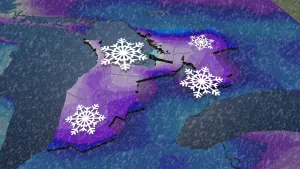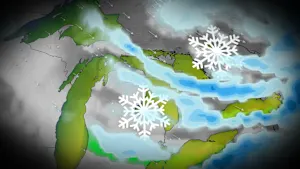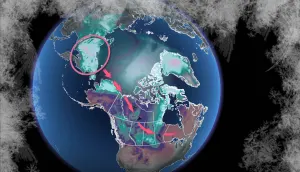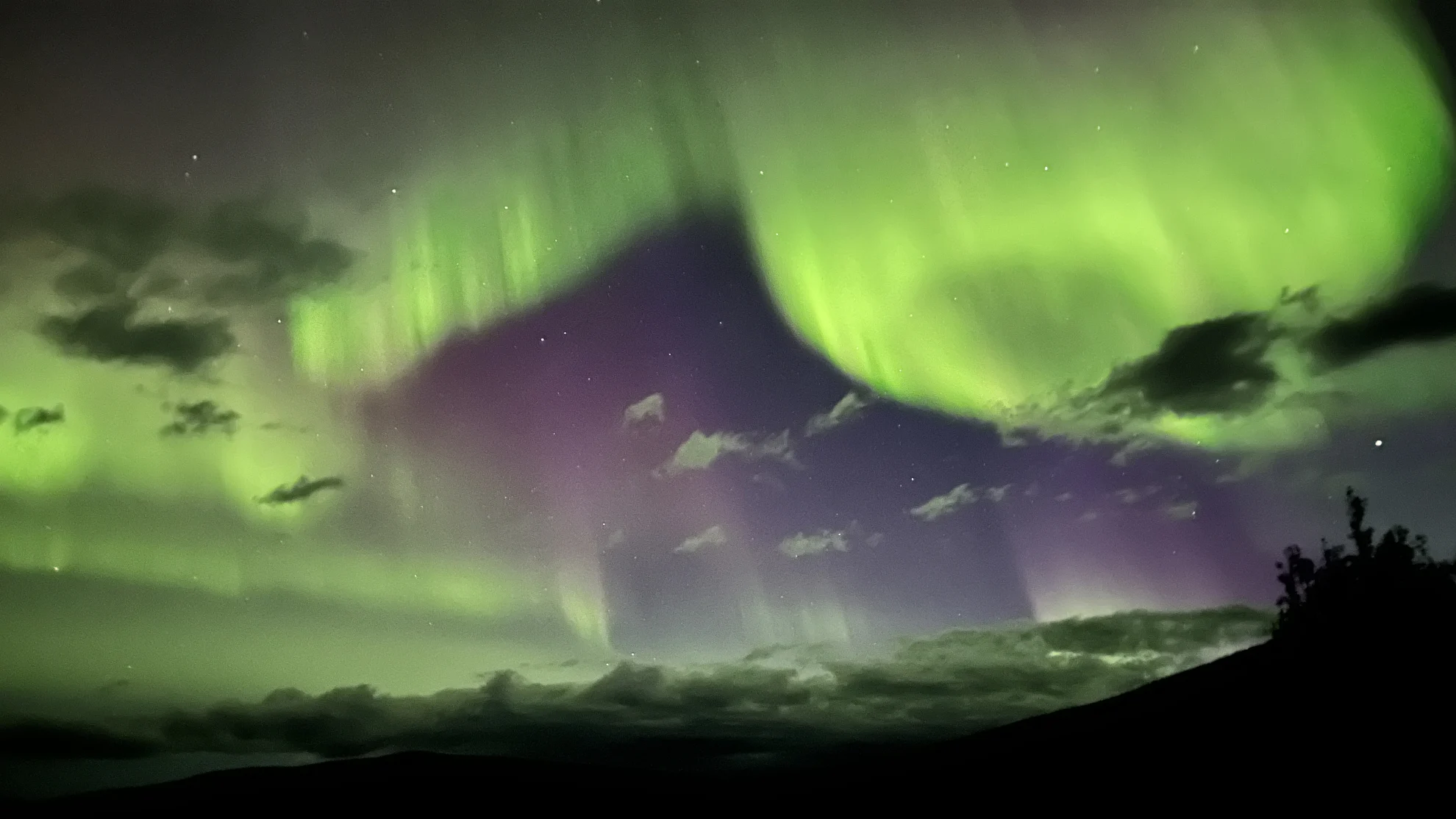
Solar max has arrived! Here’s how and where to see the Northern Lights
Solar Maximum is now upon us, making the next year the best time to witness the Aurora Borealis. So, don’t miss out!
So far in 2024, we have already seen some amazing displays of the Northern Lights. With Aurora Season upon us now, and the Sun having now reached Solar Maximum, we will no doubt see more of this spectacular phenomenon. Here’s our guide to the science behind the auroras and where you can go to see them best.
On the night of May 10, 2024, people across Canada and the United States looked up to witness one of the best displays of the Aurora Borealis in more than 20 years. Reports stated that the geomagnetic storm responsible for the event was the strongest since Halloween 2003.
Although referred to as a “once-in-a-lifetime” event, in the months since, the Northern Lights have already put in a number of similar appearances across our skies. This is due to the Sun becoming more active, as we approach ‘solar maximum’.
What are the auroras?
The Aurora Borealis is a colourful display of light that shines high up in the night sky.
Sometimes faint and at other times bright, these ‘Northern Lights’ can appear to dance through the sky above, forming curtains, sheets, ribbons, and even vibrant ‘coronae’ if they pass directly overhead. The auroras are often thought of as quite fickle or even “mischievous” at times, as they can appear nearby and bright one moment, only to fade or retreat far away the next.
The most common colour for the auroras is green. However, they can also frequently show up in hues of red, blue, and purple. In rare instances, shades of pink, yellow, and even orange can also appear.
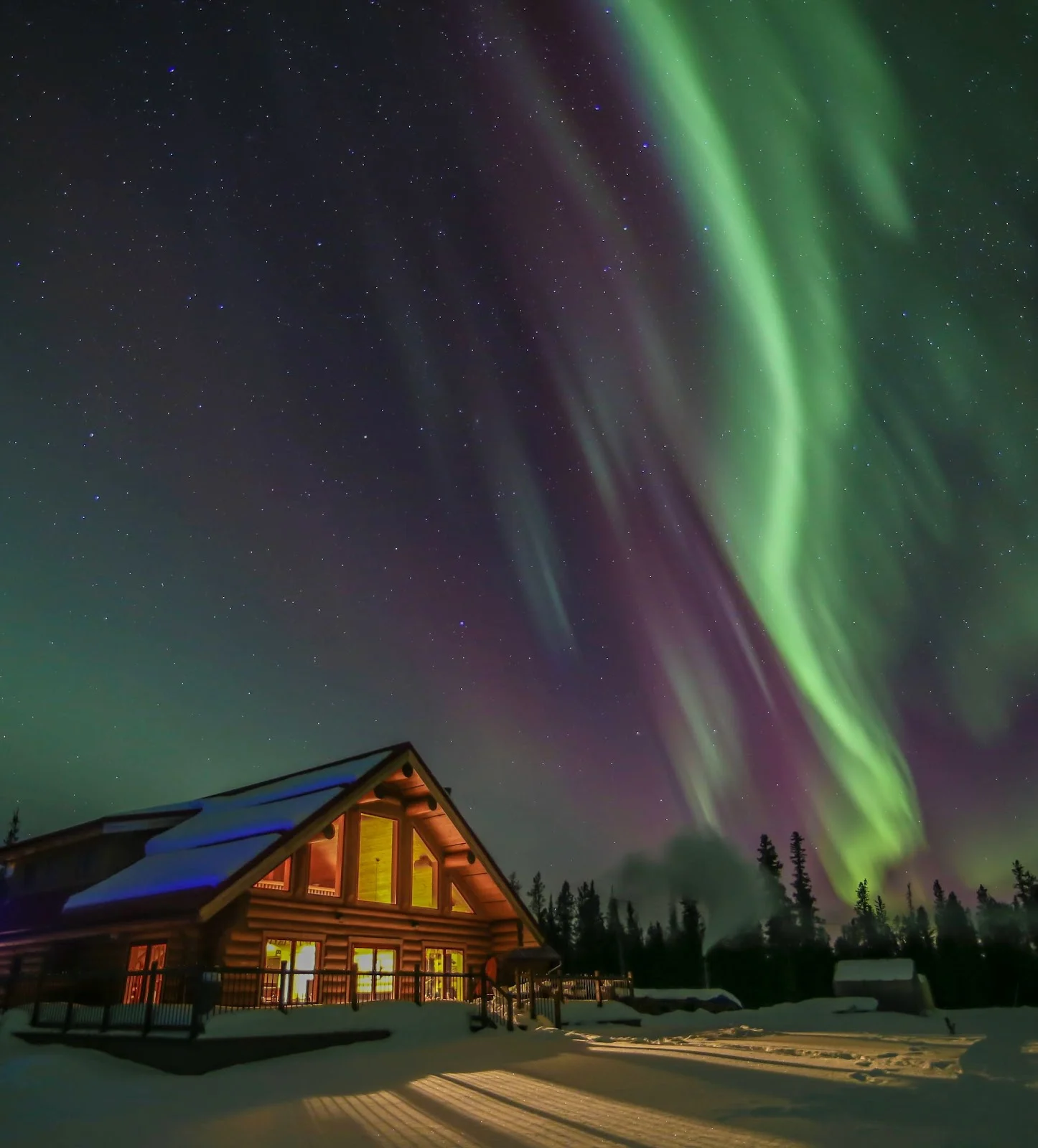
Courtesy Travel Yukon, Northern Lights Resort & Spa
Each of these colours results from the same process. High-energy particles from the Sun — mainly electrons arriving via the solar wind or inside a ‘solar storm’ cloud — plunge into Earth’s upper atmosphere. There, the particles smack into atoms or molecules of oxygen, nitrogen, and other gases in the air, passing on some of their energy. That excess energy is then released by those atoms and molecules as flashes of coloured light.
The exact colours present in an aurora display depends on a few factors. Each atmospheric component emits light at a different wavelength, plus we tend to find specific atoms or molecules at different levels of the atmosphere. Also, the intensity of the aurora event matters, as some colours need to be very bright for us to even notice them, while others don’t show up at all except during the strongest events.
Green auroras are produced by molecules of oxygen, between 100 and 300 kilometres above the ground. At altitudes of 300 to 400 km, though, atomic oxygen emits red light. Although this red might be present at any time that we see the green auroras, it is more difficult for the human eye to detect.
During intense auroras, the increase in the number of solar particles streaming in from space causes the greens and reds from oxygen to become more vibrant. At the same time, the massive influx of particles causes nitrogen molecules to emit their own light as well. This shows up as blue at higher altitudes, which can combine with the brighter red from oxygen, resulting in purple. Shades of pink and dark red can also appear along the base of an aurora display, as more solar particles are able to reach nitrogen molecules deeper down in the atmosphere.

Ribbons of the Northern Lights stretched across the sky from Whitehorse, YT, on August 31, 2012. Credit: David Cartier Sr/NASA Goddard
Blue and purple auroras have also been attributed to hydrogen and helium atoms, at very high altitudes, which are impacted during strong geomagnetic events. Orange is an extremely unusual shade of aurora, as there is not one particular component of the atmosphere that can produce that colour on its own. Similar to how the red from oxygen and blue from nitrogen combine into purple, though, researchers have found that red and green auroras may combine to produce a yellow-orange glow.
The different shapes the auroras can take, and their apparent motion, is the result of the movement of the air in the upper atmosphere. The air that high up tends to be quite stable, allowing for these displays to form into curtains of rainbow hues that can persist for some time. However, auroras produce a significant amount of heat along with the light. This heat has a destabilizing effect on the atmosphere, which can then cause those colours to become more mixed, and for the shapes to take on a much more active dance across the sky.
DON'T MISS: The Fall 'Season of Meteor Showers' may include rare astronomical treats
Where do the auroras come from?
Every display of the Northern Lights, regardless of their location, shape, colour, or extent, can ultimately be traced back to one origin point — the Sun.
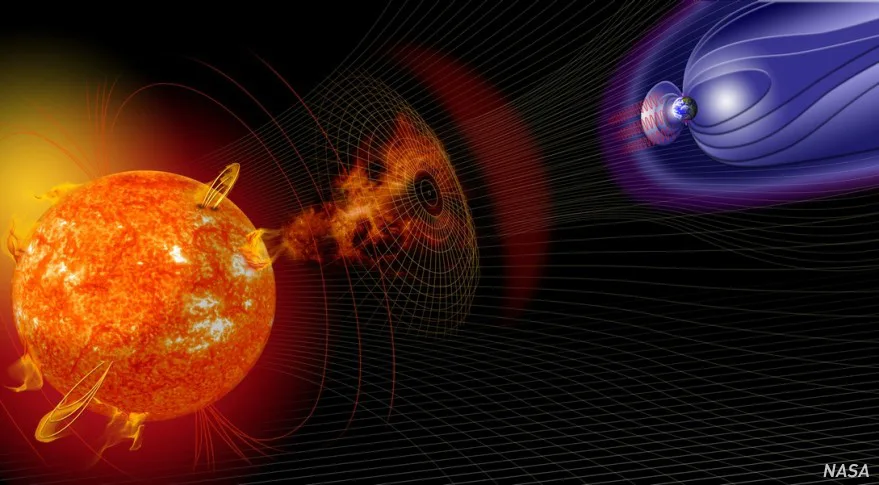
This artist’s impression reveals the various ways in which solar activity can affect the Earth, which is collectively known as ‘space weather’. Immense coronal loops stretch away from the Sun’s ‘surface’ (left), with giant prominences arcing across its surface as well. Left of centre, a solar flare causes an immense cloud of solar particles — a coronal mass ejection (centre) — to be flung away from the Sun, headed towards Earth. At Earth (right), x-rays from the solar flare (in red) ‘impact’ on the planet’s ionosphere, while the planet’s geomagnetic field (in blue) deflects most particles from the solar wind around the planet, while some stream into the atmosphere at the poles to produce auroras. (NASA)
Although the Sun may seem constant and unchanging from our vantage point here on Earth, it is really an active star. Even during its most quiet times, there is a constant flow of high-energy particles from the Sun’s atmosphere into space. We call this flow the solar wind, and just like the wind here on Earth, at times it blows slowly and calmly, while at other times it is considerably more blustery. During the Sun’s more active periods, it produces intense solar flares and immense eruptions of solar matter into space known as coronal mass ejections.
Collectively, these various phenomena are called ‘space weather’, and each aspect of space weather has its own specific impacts on Earth.

In this simulation, Earth’s geomagnetic field (blue lines) captures solar particles (white), directing them down towards the planet’s poles, where they generate auroral displays. (NASA)
As the solar wind flows past us, Earth’s geomagnetic field captures some of the particles from the stream and funnels them down into the upper atmosphere near the north and south poles. Under ‘normal’ conditions, this results in auroras that tend to be confined to the farthest northerly and southerly regions of the planet.
During the sun’s more active periods, we can encounter faster flows of the solar wind. These originate from coronal holes — immense regions of the solar atmosphere (the corona) that become exposed to space due to the arrangement of the Sun’s magnetic fields.
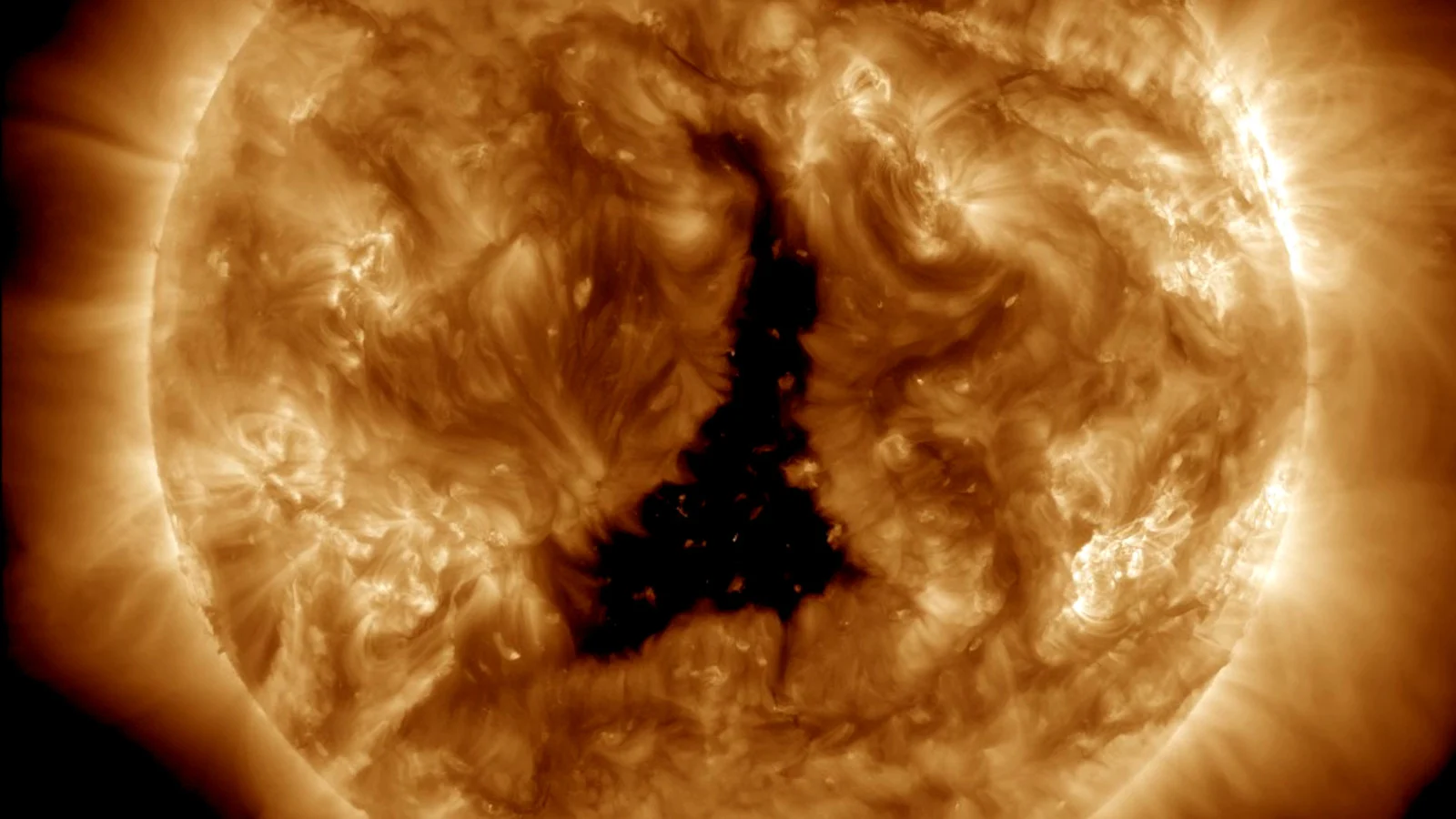
This image of the Sun, taken in extreme ultraviolet light by NASA’s Solar Dynamics Observatory on December 2, 2023, shows an immense, dark coronal hole, where a gap in the Sun’s magnetic field had exposed the Sun’s atmosphere to space. (NASA SDO)
As Earth crosses the boundary where the normal solar wind flow gives way to one of these high-speed streams, we can encounter a buildup of high-energy particles. This typically results in stronger auroras as more of those particles are captured by Earth’s magnetic field.
When a coronal mass ejection (CME or ‘solar storm’) sweeps past Earth, we can see even stronger impacts.
Even a fairly small CME can spark a brief uptick in aurora activity when it arrives here. However, as you ramp up the density, speed, and energy of a passing CME, the chances of seeing very intense Northern Lights, far south of where they normally show up, significantly improve.

This immense coronal mass ejection (CME) erupted from the Sun on August 31, 2012, and was captured in great detail by NASA’s Solar Dynamics Observatory. A graphic of Earth has been added to the image to properly scale this monster eruption. (NASA/Goddard Space Flight Center)
Simply increasing one of those three factors — the density, for instance — can produce a very memorable aurora event. If a particularly dense CME erupts following a powerful X-class solar flare, though, the particles in the cloud will absorb a lot of energy from that flare. In such a case, we could be treated to a display of the Northern Lights better than anything witnessed in decades.
Now, if that dense, highly-energized solar storm also took less than a day to traverse the distance between the Sun and Earth, compared to the normal 2-3 day duration for such a trip, we might be in for some trouble. In addition to extremely bright auroras visible from nearly everywhere on the planet (even near the equator), the rapid influx of so many extremely energetic solar particles, all at once, would cause an intense shock to Earth’s magnetic field.
The resulting disturbance, known as a geomagnetic storm, could potentially rival the 1859 Carrington Event or the 1921 New York Railway Storm - two of the most infamous solar events in history. During each, fluctuations in Earth’s magnetic field induced strong currents in the telegraph and power grids that existed at the time. Operators experienced electric shocks from their equipment and in some cases the lines caught fire. If something similar happened now, it could cause a significant worldwide blackout.
SEE MORE: Perseids and vibrant auroras shine bright across Canada and globally
Where to see the auroras for Solar Maximum?
Even after the amazing displays we’ve witnessed so far in 2024, solar activity continues to increase. It has even significantly outpaced what scientists originally predicted for this cycle.
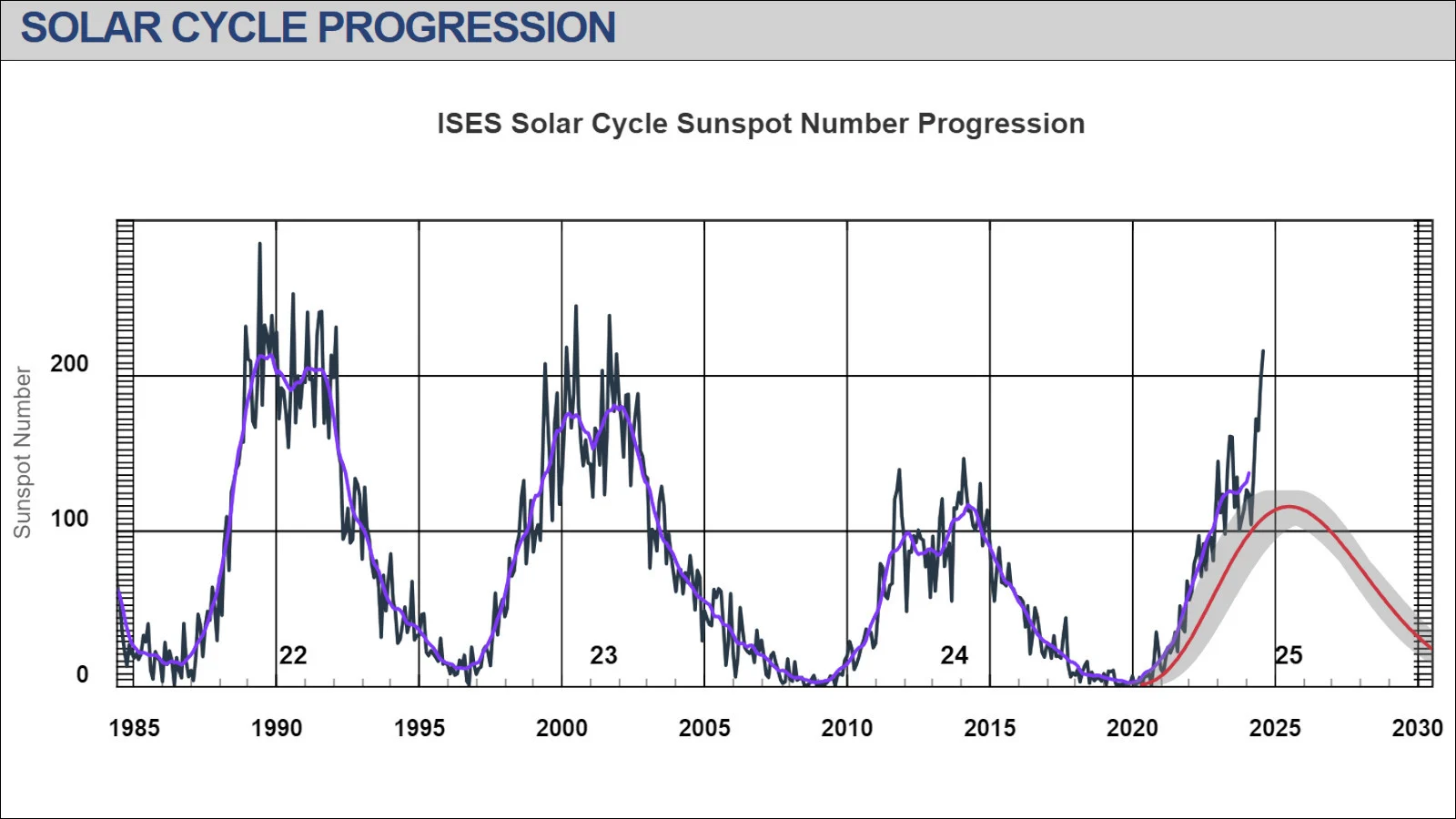
The progression of the current Solar Cycle 25 (far right) is shown here compared to the previous three cycles. While the red curve represents the original predicted strength of the current cycle, the black line represents the true sunspot count (a measure of the cycle’s activity), up to and including August 2024. (NOAA SWPC)
Based on this, it’s reasonable to assume that the Northern Lights will put on even better shows between now and early 2026.
If we plan ahead, there are ways to make the most out of the coming opportunities for aurora viewing.
Firstly, we can keep an eye on space weather forecasts, from agencies like NRCan’s Canadian Space Weather Forecast Centre or NOAA’s Space Weather Prediction Center, and news sources like The Weather Network, to know when a significant geomagnetic storm is in the forecast. Here at the Weather Network, we observers should try to get as far away from city light pollution as they can.
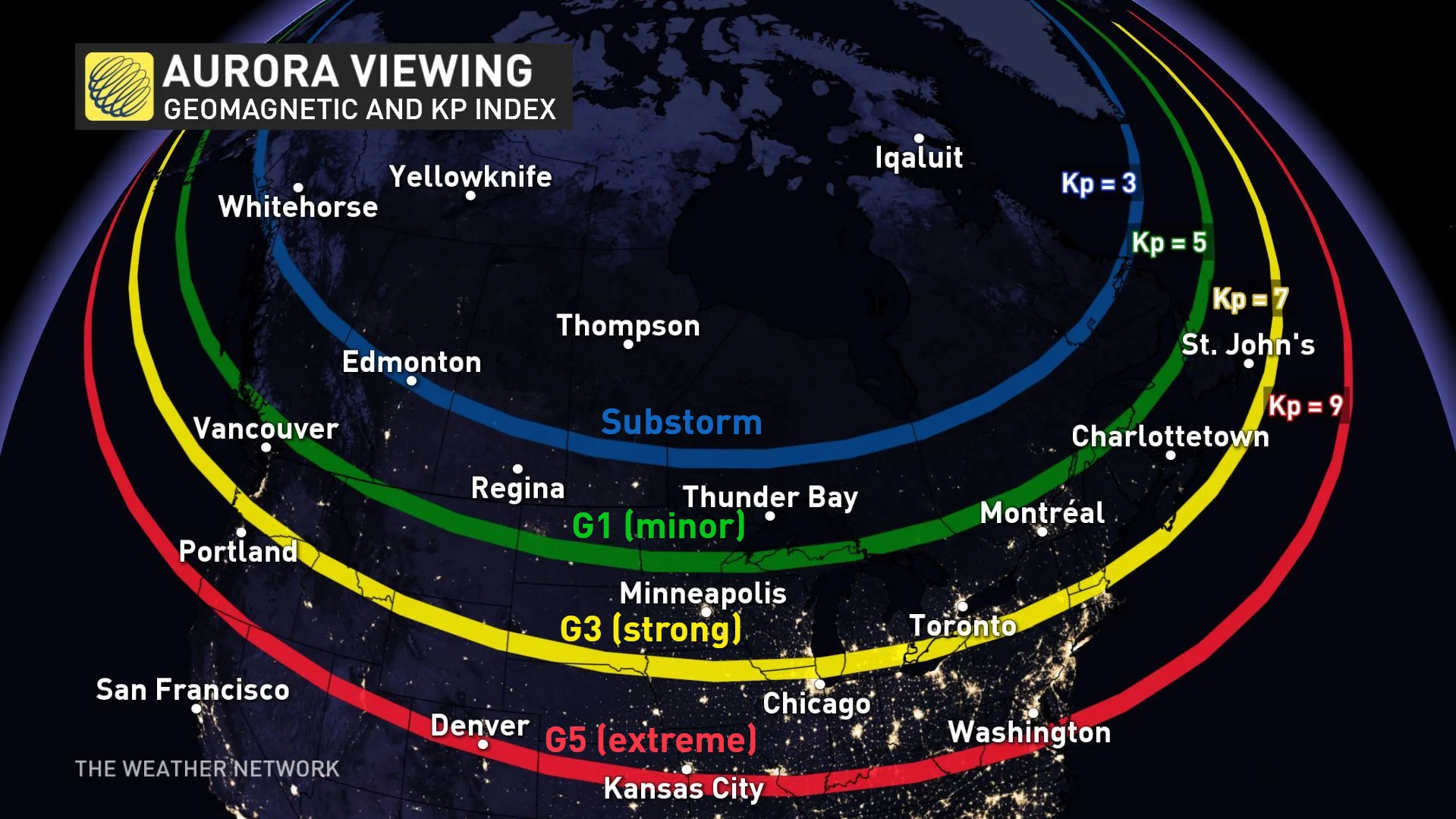
This map shows the typical southerly extent of the Northern Lights under different conditions. A Planetary K-Index (Kp) of less than 5 represents ‘substorm’ levels, when auroras are usually confined to northern regions of the country. Each coloured line here is a jump in geomagnetic storm level, with Kp 5 equivalent to a G1 (minor) geomagnetic storm and Kp 9 being a G5 (extreme) storm. (The Weather Network)
It is often difficult enough to see auroras, even with dark skies above. However, light pollution impacts our eyes’ ability to adapt to the dark. This diminishes our ability to see fainter sources of light, like the auroras. This is especially true in and around large cities, or when surrounded by multiple urban centres, as is common in Canada’s southern regions.
Getting out into rural areas, or perhaps finding a nearby Dark Sky site, can immensely improve your viewing potential. Once there, limiting your exposure to light will allow your eyes to better adapt to the dark. Keep streetlights and car lights out of your direct line of sight, and reduce the brightness of your smartphone screen as much as you can (as you may need it).
Some aurora displays will be very bright, with vibrant colours that are plainly visible to the unaided eye. However, this is not always the case. Since the human eye does not pick up colours very well in the dark, you might see the shapes of the aurora above you, but the colours may be very muted. This is where your smartphone will help. The camera’s Night Sight or Night Mode function will take long-exposure images, revealing more of the colours that your eye missed.
READ MORE: How to get the most out of meteor showers and other night sky events
Aurora destinations
Those interested in getting farther away to see the auroras, to somewhere they can appear more consistently, might consider heading north.
In particular, Whitehorse, Yukon, can experience some spectacular displays of the Northern Lights. This is true for exceptional events that can also be seen from southern regions of the country, but also during the more quiet times when the auroras are confined to the north. In addition, the longer nights, which can last between 13 to 15 hours, provide a much better chance of seeing them.
Glancing through nighttime imagery from NASA’s Suomi NPP satellite reveals that nearly half of all nights between the beginning of January through the end of April, in 2024, featured at least a brief appearance by the auroras over southern or central Yukon. A fair number of those displays were very bright and widespread. Picking up the viewing again in August, when Aurora Season began again, showed a similar trend, with a marked increase in aurora nights going into September.
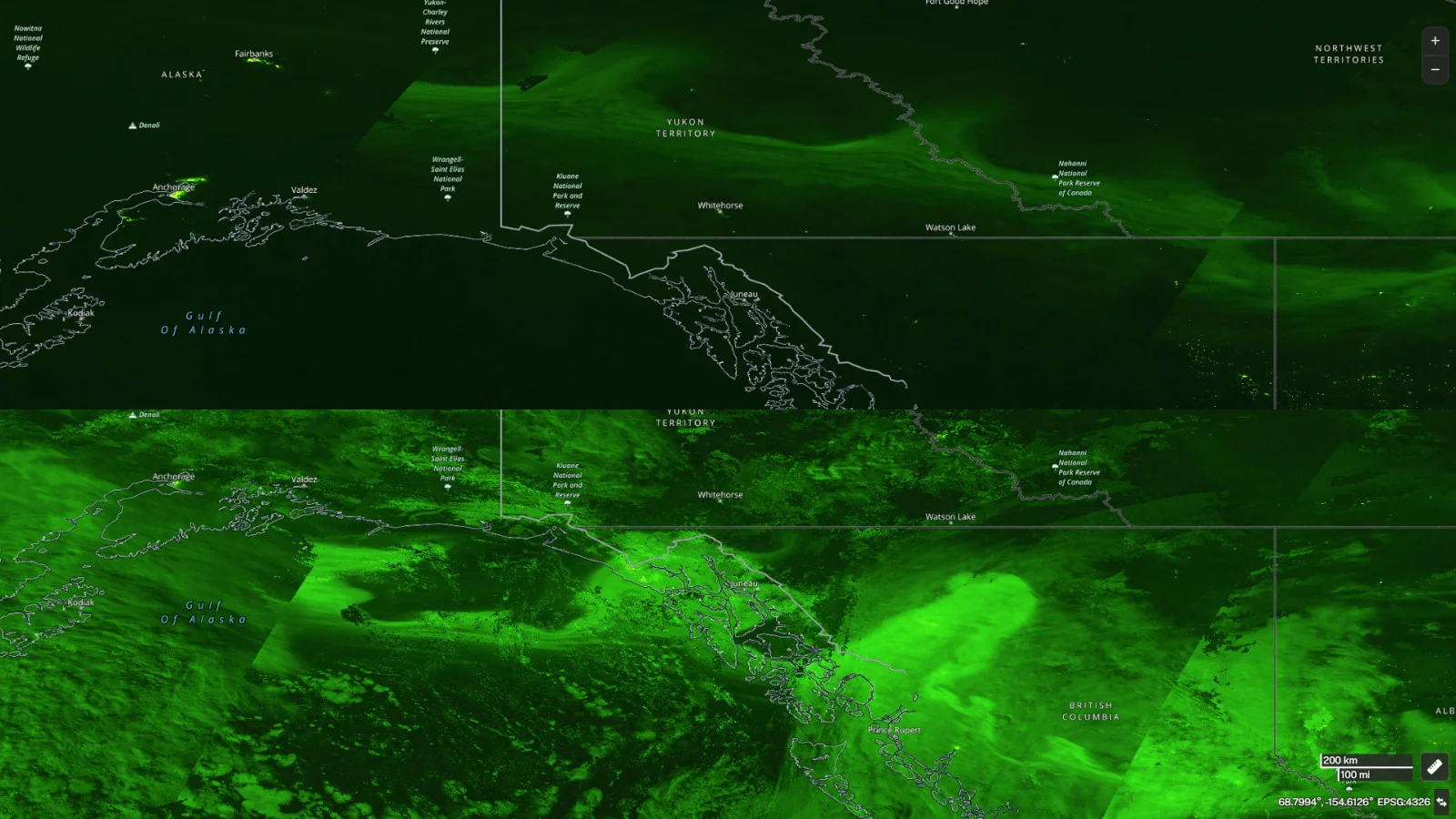
These two images were captured on Feb 11, 2024 (top) and Sep 17, 2024 (bottom), by the polar-orbiting Suomi NPP weather satellite as it passed over the Northwestern parts of Canada and eastern Alaska. Auroras, shown in green, stretched across the region in a wavy arc on Feb 11, representing a fairly typical night over southern. The Northern Lights were bright and widespread over this same region on Sep 17, representing a significant aurora event. (NOAA/NASA Worldview)
According to Travel Yukon, the Northern Lights has become one of the most popular reasons to visit Whitehorse and the surrounding communities.
Although the location may be remote, you wouldn’t necessarily be on your own. As Travel Yukon says on their website, there are several ways to experience the auroras from the area. Local operators conduct nightly tours, while wilderness lodge and cabin experiences offer a way to view them on your own schedule. They even recommend Dawson City’s Midnight Dome as an excellent place from which to view the Northern Lights.
Solar Maximum is here!
In an update on October 15, 2024, scientists from NASA and NOAA announced that the Sun has reached its maximum activity for Solar Cycle 25!

Solar activity in December 2019, at the start of Solar Cycle 25 (left) versus activity in October 2024, at the beginning of the period of solar maximum for this cycle (right). These views, captured by NASA's Solar Dynamics Observatory, filter for extreme ultraviolet light emitted at temperatures of around 1 million Kelvin, showing off arcs of solar plasma known as 'coronal loops' and regions where the magnetic field near the surface is exceptionally strong. (NASA SDO)
This doesn't mean that activity will ramp down from here. In fact, the "fun" has just begun.
"This announcement doesn't mean that this is the peak of solar activity we'll see this solar cycle," Elsayed Talaat, the director of space weather operations at NOAA, said in the press conference. "While the Sun has reached the solar maximum period, the month that solar activity peaks on the Sun will not be identified for months or years."
The period of solar maximum is a roughly year-long stretch of time in the middle of an 11-year solar cycle when we see the greatest amount of activity from the Sun.
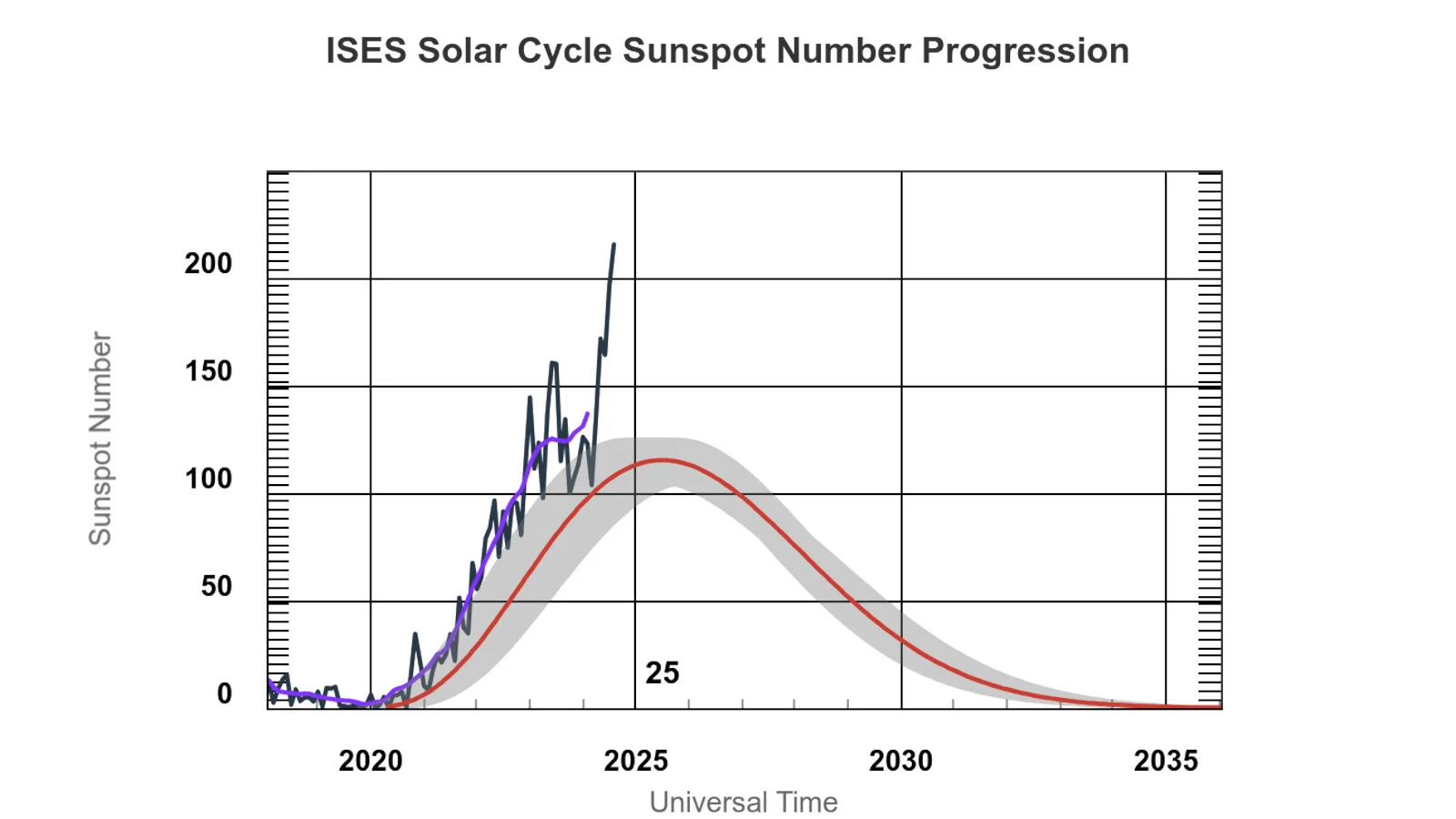
The prediction and progression of Solar Cycle 25 up to September 2024. (NOAA SWPC)
The exact peak of the cycle will only be identified after it has occurred, NASA said. As shown by the black line in the graph above, while solar activity does follow an overall pattern of increasing up to the peak and then decreasing after, the exact amount of activity we see on a daily, weekly, and even monthly basis is a bit more random. To specifically point to the peak of this cycle, solar scientists will need to wait until they observe a consistent decrease in solar activity over time.





